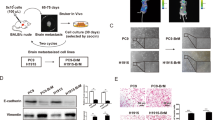Abstract
Lung cancer is the leading cause of cancer deaths in the world. Brain metastasis (BM) can affect about 25% of non-small cell lung cancer (NSCLC) patients during their lifetime. Efforts to characterize patients that will develop BM have been disappointing. MicroRNAs (miRNAs) play a role in regulating a variety of targets and, consequently, multiple pathways, which make them a powerful tool for early detection of disease, risk assessment and prognosis. In this study, using RT-PCR and further northern blot validation, we confirmed that miR-378 was significantly differentially expressed in the matched NSCLC from 8 patients with BM and 21 without BM. Our study showed evidences that miR-378 is associated with non-small cell lung cancer brain metastasis by promoting cell migration, invasion and tumor angiogenesis. MiR-378 may be a potential biomarker for characterizing non-small cell lung cancer brain metastasis and assisting clinicians in stratifying the high-risk patients on a clinical trial for either prophylactic cranial irradiation or a new intervention that may mitigate BM development, ultimately leading to a new standard of care for NSCLC patients.








Similar content being viewed by others
References
Jemal A, Siegel R, Ward E, Murray T, Xu J, et al. Cancer statistics, 2007. CA Cancer J Clin. 2007;57(1):43–66.
Grinberg-Rashi H, Ofek E, Perelman M, Skarda J, Yaron P, et al. The expression of three genes in primary nonsmall cell lung cancer is associated with metastatic spread to the brain. Clin Cancer Res. 2009;15(5):1755–61.
Laack NN, Brown PD. Cognitive sequelae of brain radiation in adults. Semin Oncol. 2004;31(5):702–13.
Oh Y, Taylor S, Bekele BN, Debnam JM, Allen PK, et al. Number of metastatic sites is a strong predictor of survival in patients with nonsmall cell lung cancer with or without brain metastases. Cancer. 2009;115(13):2930–8.
Lu J, Getz G, Miska EA, Alvarez-Saavedra E, Lamb J, et al. MicroRNA expression profiles classify human cancers. Nature. 2005;435(7043):834–8.
Liu CG, Calin GA, Volinia S, Croce CM. MicroRNA expression profiling using microarrays. Nat Protoc. 2008;3(4):563–78.
Lee DY, Deng Z, Wang CH, Yang BB. MicroRNA-378 promotes cell survival, tumor growth, and angiogenesis by targeting SuFu and Fus-1 expression. Proc Natl Acad Sci USA. 2007;104(51):20350–5.
Arora S, Ranade AR, Tran NL, Nasser S, Sridhar S, et al. MicroRNA-328 is associated with (non-small) cell lung cancer (NSCLC) brain metastasis and mediates NSCLC migration. Int J Cancer. 2011; [Epub ahead of print].
Schmittgen TD, Jiang J, Liu Q, Yang L. A high-throughput method to monitor the expression of microRNA precursors. Nucleic Acids Res. 2004;32(4):e43.
Coleman JE, Huentelman MJ, Kasparov S, Metcalfe BL, Paton JF, et al. Efficient large-scale production and concentration of HIV-1-based lentioviral vectors fr use in vivo. Physiol Genomics. 2003;12(3):221–8.
Hua Z, Lv Q, Ye W, Wong CK, Cai G, et al. MiRNA-directed regulation of VEGF and other angiogenic factors under hypoxia. PLoS ONE. 2006;1:e116.
Sheng W, Wang G, Wang Y, Liang J, Wen J, et al. Roles of versican V1 and V2 isoforms in cell proliferation and apoptosis. Mol Biol Cell. 2005;16(3):1330–40.
Saber T, Veale DJ, Balogh E, McCormick J, Nicanultaigh S, et al. Toll-like receptor 2 induced angiogenesis and invasion is mediated through the Tie2 signalling pathway in rheumatoid arthritis. PLoS One. 2011;6(8):e23540.
Chen Y, Jing Z, Luo C, Zhuang M, Xia J, et al. Vasculogenic mimicry–potential target for glioblastoma therapy: an in vitro and in vivo study. Med Oncol. 2010. doi:10.1007/s12032-010-9765-z.
Hallani SEI, Boisselier B, Peglion F, Rousseau A, Colin C, et al. A new alternative mechanism in glioblastoma vascularization: tubular vasculogenic mimicry. Brain. 2010;133(Pt4):973–82.
Pugh TJ, Gaspar LE. Prophylactic cranial irradiation for patients with lung cancer. Clin Lung Cancer. 2007;8(6):365–8.
Bartel DP. MicroRNAs: genomics, biogenesis, mechanism, and function. Cell. 2004;116(2):281–97.
Jiang J, Lee EJ, Gusev Y, Schmittgen TD. Real-time expression profiling of microRNA precursors in human cancer cell lines. Nucleic Acids Res. 2005;33(17):5394–403.
Abdulrauf SI, Edvardsen K, Ho KL, Yang XY, Rock JP, et al. Vascular endothelial growth factor expression and vascular density as prognostic markers of survival in patients with low-grade astrocytoma. J Neurosurg. 1998;88(3):513–20.
Zhou D, Cheng SQ, Ji HF, Wang JS, Xu HT, et al. Evaluation of protein pigment epithelium-derived factor (PEDF) and microvessel density (MVD) as prognostic indicators in breast cancer. Cancer Res Clin Oncol. 2010;136(11):1719–27.
Maniotis AJ, Folberg R, Hess A, Seftor EA, Gardner LM, et al. Vascular channel formation by human melanoma cells in vivo and in vitro: vasculogenic mimicry. Am J Pathol. 1999;155(3):739–52.
Sun B, Qie S, Zhang S, Sun T, Zhao X, et al. Role and mechanism of vasculogenic mimicry in gastrointestinal stromal tumors. Hum Pathol. 2008;39(3):444–51.
Guzman G, Cotler SJ, Lin AY, Maniotis AJ, Folberg R. A pilot study of vasculogenic mimicry immunohistochemical expression in hepatocellular carcinoma. Arch Pathol Lab Med. 2007;131(12):1776–81.
Oka N, Soeda A, Inagaki A, Onodera M, Maruyama H, et al. VEGF promotes tumorigenesis and angiogenesis of human glioblastoma stem cells. Biochem Biophys Res Commun. 2007;360(3):553–9.
Conflict of interest
The authors report no conflict of interest concerning the materials or methods used in this study or the findings specified in this paper.
Author information
Authors and Affiliations
Corresponding author
Rights and permissions
About this article
Cite this article
Chen, Lt., Xu, Sd., Xu, H. et al. MicroRNA-378 is associated with non-small cell lung cancer brain metastasis by promoting cell migration, invasion and tumor angiogenesis. Med Oncol 29, 1673–1680 (2012). https://doi.org/10.1007/s12032-011-0083-x
Received:
Accepted:
Published:
Issue Date:
DOI: https://doi.org/10.1007/s12032-011-0083-x




